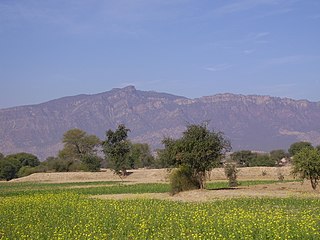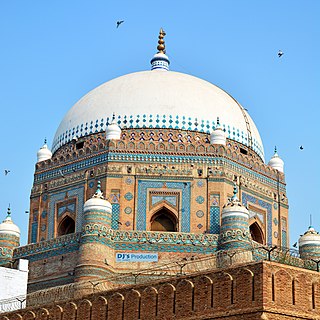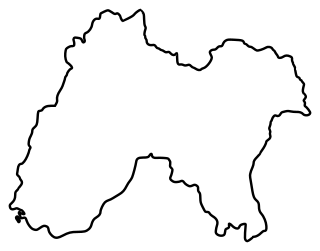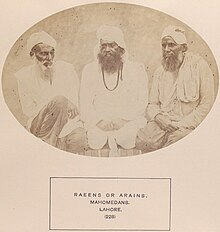The Punjabis are an Indo-Aryan ethnolinguistic group associated with the Punjab region, comprising areas of eastern Pakistan and northwestern India. They generally speak Standard Punjabi or various Punjabi dialects on both sides.

The Shalimar Gardens are a Mughal garden complex located in Lahore, Punjab, Pakistan. The gardens date from the period when the Mughal Empire was at its artistic and aesthetic zenith, and are now one of Pakistan's most popular tourist destinations.

The Kamboj, also Kamboh, is a caste and cultivating community of India and Pakistan that originated from the central Punjab region.

Jhang is the capital city of Jhang District in the central portion of the province of Punjab, Pakistan. Situated on the east bank of the Chenab river, it is the 18th largest city of Pakistan by population.

Ishtiaq Ahmed is a Swedish political scientist and author of Pakistani descent. He holds a PhD in Political Science from Stockholm University. He is Professor Emeritus of Political Science at Stockholm University. Ahmed’s work provides a comprehensive and critical examination of the political history of South Asia, particularly focusing on the partition of India and the role of key figures like Jinnah. His writings offer valuable insights into the complex dynamics of religion, language, and politics in the region.
Muslim communities in South Asia apply a system of social stratification. The stratification that operates among Muslims arises from concerns other than in the concepts of pure and impure that are integral to the Indian caste system. It developed as a result of relations between the foreign conquerors and local upper caste Hindus who were forced to convert to Islam (Ashraf) and the local lower caste converts (Ajlaf) as well as the continuation of the Indian caste system among local converts. Non-Ashrafs are backward caste converts. The neologism "Pasmanda" includes Ajlaf and Arzal Muslims, and Ajlafs' statuses are defined by them being the descendants of converts to Islam and are also defined by their pesha (profession). These terms are not used in local, sociological vocabulary in places such as Kashmir and Uttar Pradesh, and therefore tell us very little about the functioning of Muslim society.

Belonging to the Arain tribe of Punjab region. The family has made great contributions to the region and owned the land near Baghbanpura on which the Shalimar Gardens (Lahore) were built. The land was handed to the Mughal Emperor, Shah Jahan and in return custodianship of the Shalimar Gardens, Lahore was granted to the family in 1641.

Renala Khurd is an administrative subdivision (tehsil) of Okara District in the Punjab province of Pakistan. It is administratively subdivided into 18 Union Councils, two of which form the tehsil capital Renala Khurd.

Pial Kalan is a town and Union Council of Kasur District, There are 4 main residential areas of Pial Kalan, Ittehad Colony, Mohallah Arrian, Mohallah Kambohan wala, and Mian Mohallah. Ittehad Colony is the Main and Biggest Area of Pial Kalan. Pial Kalan is situated in District Kasur in the Punjab province of Pakistan. It is part of Kasur Tehsil and is located at 30°55'0N 74°13'60E with an altitude of 181 metres (597 feet).

Kashmiri Muslims are ethnic Kashmiris who practice Islam and are native to the Kashmir Valley, an area that includes the India-administered territories of Jammu and Kashmir and Ladakh, the Pakistan-administered territories of Azad Kashmir and Gilgit-Baltistan, and the Chinese-administered territories of Aksai Chin and the Trans-Karakoram Tract. The majority of Kashmiri Muslims are Sunni. They refer to themselves as "Koshur" in their mother language.

The Pothohar plateau, is a plateau situated in northern Punjab, Pakistan. It is bounded on the east by the Jhelum River, on the west by the Indus River, on the north by the Kala Chitta Range and the Margalla Hills, and on the south by the Salt Range.
Punjabi Muslims are adherents of Islam who identify ethnically, linguistically, culturally, and genealogically as Punjabis. With a population of more than 109 million, they are the largest ethnic group in Pakistan and the world's third-largest Islam-adhering ethnicity after Arabs and Bengalis. The majority of Punjabi Muslims are adherents of Sunni Islam, while a minority adhere to Shia Islam. They are primarily geographically native to the Punjab province of Pakistan, but many have ancestry from the Punjab region as a whole.
The Kashmiris in Punjab are ethnic Kashmiris who have historically migrated from the Kashmir Valley and settled in the Punjab region. Many ethnic Muslim Kashmiris from the Kashmir Valley had migrated to the Punjab region during Sikh and Dogra rule.
The Mian is a Pakistani Punjabi noble Arain family who were the owner of Ishaqpura region, the territory where the Mughal Empire wanted to build a Garden named as Shalimar in Lahore.

Sufism has played a major role in the history of Punjab. West Punjab is heavily influenced by Sufi Saints and major Sufi Pirs. The partition in 1947 led to the almost complete departure of Muslims from East Punjab. The Sufi shrines in the region continue to thrive, particularly among so-called ‘low’ caste Dalits that constitutes more than 30% of its population. After the partition the Dalit community took over the care of Sufi shrines in the East Punjab.

Elections to the Punjab Provincial Assembly were held in January 1946 as part of the 1946 Indian provincial elections.

The Mian or miyan is a royal title of the Arain Tribe of Indian subcontinent, also sometimes used as a surname. Begum or Beygum, is used to describe the wife of a Mian. It is used by several monarchs of Indian states.












